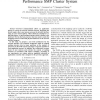Free Online Productivity Tools
i2Speak
i2Symbol
i2OCR
iTex2Img
iWeb2Print
iWeb2Shot
i2Type
iPdf2Split
iPdf2Merge
i2Bopomofo
i2Arabic
i2Style
i2Image
i2PDF
iLatex2Rtf
Sci2ools
CLUSTER
2008
IEEE
2008
IEEE
Context-aware address translation for high performance SMP cluster system
—User-level communication allows an application process to access the network interface directly. Bypassing the kernel requires that a user process accesses the network interface using its own virtual address which should be translated to a physical address. A small caching structure which is similar to the hardware TLB on the host processor has been used to cache the mappings between virtual and physical addresses on the network interface memory. In this study, we propose a new TLB architecture for the network interface. The proposed architecture splits an original caching structure into as many partitions as the number of processors on the SMP system and assigns a separate partition to each application process. In addition, the architecture becomes aware of user contexts and switches the content of caching structure in accordance with context switching. According to our experiments, our scheme achieves significant reduction in application execution time compared to the previous ap...
| Added | 29 May 2010 |
| Updated | 29 May 2010 |
| Type | Conference |
| Year | 2008 |
| Where | CLUSTER |
| Authors | Moon-Sang Lee, Joonwon Lee, Seungryoul Maeng |
Comments (0)

